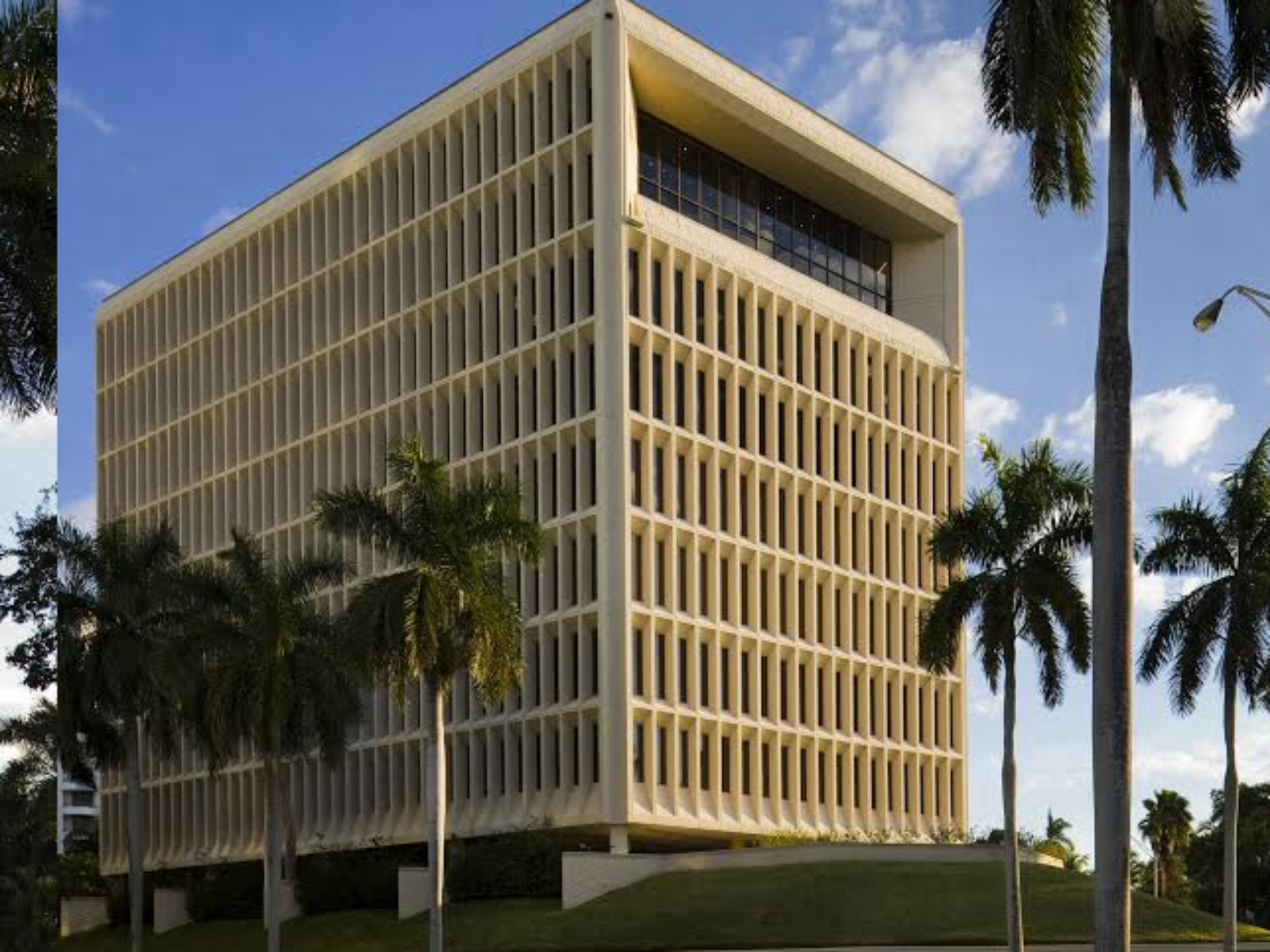In its application, Docomomo US cited the following reasons for preserving the building:
Unique Example of Mid-Century Architecture
Built almost 50 years ago, this is an award-winning outstanding example of Mid-century architecture in South Florida that should be preserved. Sited on tall green berms overlooking the intersection of 27th Avenue and South Bayshore Drive, the elegant Office in the Grove tower marked an important step in the evolution of Coconut Grove. Its compact form set amid greenery and art meshes business culture with the Grove’s relaxed lifestyle and historical landmarks.
Innovation
A Landscape Berm...Pedestrian Friendly
Office in the Grove is an eight-story hexagon tower floating over a three-level, grass-landscaped pedestal. This was Miami's first office building to give the community an eye-level, landscaped grass berm as its facade.
No Surface Parking Lot
Office in the Grove is placed with maximal views of Biscayne Bay with ample parking yet without the traditional and often distasteful asphalt or concrete parking lot. Instead, the parking is hidden behind environmentally friendly levels: one below ground, cut into the coral rock ridge (a first); a second is hidden behind a broad, sloping grass berm (a first); and the third, parking is nestled in the shade under the tower’s raised stilts concealed by battered concrete decorative, fern planters (a first).
Innovated Methods of Construction
Office in the Grove was one of the first to use post-tensioned concrete slabs & a completely prefabricated concrete façade.
Integration
Integration of Landscape & Architecture
The landscaping is not a decorative add-on but part of the architectural design. The form, shape and slope of the grass berm is part of the building’s architectural form; it mirrors the concrete battered walls and below the triangular concrete, fern planters. The tall Royal Palms on 27th Ave. and the building’s point, all planted in 1970, are part of the original architecture.
Integration of Architecture & Art
Office in the Grove is resplendent with integral ornamentation, the theme - the Everglades, casted directly into the pedestal’s concrete base and also in the small, personal lobby (this was the first time carved Styrofoam was used to replicated hand carved stone).
Adaptation
Adaptation to South Florida Environment
The façade is completed shaded and protected from storm by a precast grill, with maximum bay views. In addition, its central core opens to the bay by a wedge “V” cut into the building that brings light and views to each elevator foyer. The offices, placed around this core, do not need the traditional long office corridors.
About the Architect
Architect Kenneth Treister, FAIA, born 1930, is an internationally known architect and author of ten books on architecture; Fellow in the American Institute of Architects; awarded the Gold Medal from the American Institute of America, Florida, their highest honor; and the Silver Metal and Lifetime Achievement Award, AIA, Miami. Office in the Grove is considered one of Treister’s finest and most important works of architecture.
Office in the Grove Awards & Publications
- Building of the Year Beautification Award from the City of Miami’s Beautification Committee, E. Albert Pallot, Chairman, 1973.
- Archived at the Smather’s Library, University of Florida, Gainesville.
- Archived at the Pratt Institute School of Design, New York.
- Featured in the 40th Anniversary Edition of Florida Architecture, 1973.
- Featured in a book of South Florida’s most important Mid-century buildings: Miami Architecture: An AIA Guide Featuring Downtown, the Beaches, and Coconut Grove, by Allan T. Shulman, Randall C. Robinson Jr., & James F. Donnelly.
Upcoming Events
The next City of Miami Historic and Environmental Preservation Board hearing will be held Tuesday, June 6 at 3 p.m. at Miami City Hall, 3500 Pan American Dr., Miami, FL 33133. To lend you voice in support, contact:
Glenda M. Puente: Docomomo US / Florida Chapter President
gpuente(AT)fiu.edu, (954) 309-8300
Jean-Francois Lejeune: Docomomo US / Florida Chapter Treasurer
flejeune(AT)miami.edu, (305) 772-6729
Gabriela Dines: Docomomo US / Florida Member
mgdines(AT)gmail.com, (786) 606 6334
Arva Parks: Historic preservationist
arvamiami(AT)bellsouth.net. (305) 854-8087
Christine Rupp: Dade Heritage Trust Executive Director
chris(AT)dadeheritagetrust.org, (305) 358-9572
Read More


